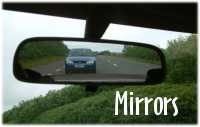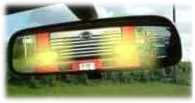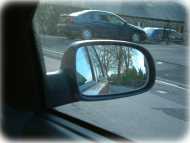Mirrors
An example of mirrors when turning left taken from our learner's video series
 Check your mirrors often so that you know what's behind at all times; make specific checks before you give signals, change direction, slow down, stop overtake or open your door.
Check your mirrors often so that you know what's behind at all times; make specific checks before you give signals, change direction, slow down, stop overtake or open your door.
The reason for always checking your mirrors before you do anything else is simple, you are asking yourself if your intended manoeuvre is safe. With this in mind, you must use your mirrors effectively and act upon what you see.
"Is it safe?"
If your intended manoeuvre is not safe, you may need to change your mind and take an alternative course of action. It is of the utmost importance that you know how your manoeuvre will affect following vehicles well before you give a signal, start to change your position or alter your speed.
In the box below there is a breakdown of the example given in the introduction for this section (here):
Red light example...
"It is important to check your mirror before starting to slow down and/or stop at a red traffic light."
If you understand why you are using your mirrors this statement will be easy to justify and to 'defend' if you have an argumentative friend, or in the case of a student instructor, an argumentative pupil or examiner.
When approaching a red traffic light, it's important to check your mirrors because:
Emergency vehicle? There could be an emergency vehicle behind. If this is the case you might have to adjust your stopping position by pulling in, mounting the kerb, or crossing the 'Stop' line.
 Too close? There may a vehicle following dangerously close - this could affect the way you use your brakes.
Too close? There may a vehicle following dangerously close - this could affect the way you use your brakes.
Lights changing? The lights might change; if they do you need to know that it is safe to accelerate.
Real danger? There is a remote possibility that there could be a vehicle with failed brakes behind. If this happened you would need to get out of the way, possibly by crossing the red light.
More than one mirror!
Notice that 'mirrors' is written as plural.
Use your mirrors in pairs, or threes, generally starting with the interior mirror and then whichever of the door mirrors (or both) will give appropriate information for your manoeuvre.
Notice the wording above: 'generally starting with the interior mirror' – there may be times, for example on a bend, when your interior mirror will not give the appropriate or sufficient information.
The usual reason for using an interior mirror first is because it gives a true representation of distance; 99% of interior mirrors are flat glass whereas many door mirrors are convex.
Convex mirrors distort images and make things appear to be further away than the actually are - always bear this in mind, especially when considering an overtaking manoeuvre on multi-lane roads. Being an experienced driver, you might have subconsciously become used to the convex mirror effect, but it's important to remember that the new drivers you will be working with do not have your (or any) experience - this is why all of these things need to be considered consciously.
Using mirrors effectively
 Simply glancing at your mirrors from time-to-time does not constitute effective use! You must use the mirrors actively.
Simply glancing at your mirrors from time-to-time does not constitute effective use! You must use the mirrors actively.
When you look into your mirrors you are actively searching for relevant information and clues regarding what might happen next and how it will affect your intended manoeuvre.
You will be asking yourself questions like
- "Will the car behind overtake?"
- "Is the other driver responding to my signal?"
- "What's happening two or three cars back?"
- "Will the cyclist try to overtake on the left?"
Remember that although we say that you should generally start your routine by using your interior mirror it will not always give you the best view. While a routine of starting with your interior mirror is good for driving discipline and the forming of good habits, it's important to gain maximum information about any danger that might be present.
Effective mirrors example
If you intend to turn right from a main road to a side road where the side road is is located on a left-hand bend, your interior mirror and right door mirrors might not give you the information you need to proceed safely.
In this instance you would need to (additionally) check the left door mirror for effective observation of the situation behind.
Not only before your manoeuvre!
 To drive safely you need to be gathering information all the time. This means before, during and after any manoeuvre.
To drive safely you need to be gathering information all the time. This means before, during and after any manoeuvre.
The final mirror checks will be to ensure that it is safe to proceed and increase speed. If the manoeuvre is one that requires an increase in speed, the final check will be after the speed increase to ensure that it is safe to sustain the speed or reduce it as required (an example might be an overtaking manoeuvre).
Next: In Step 4 we look at giving signals.